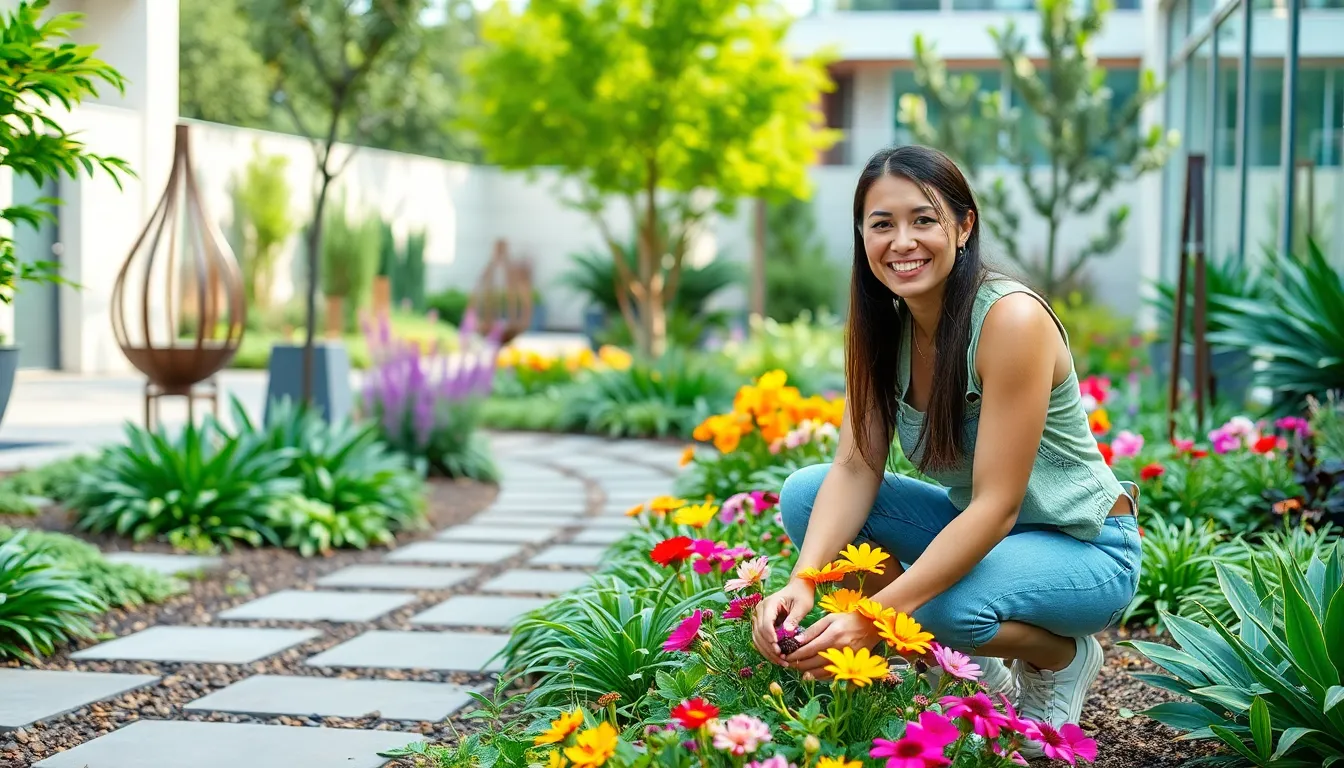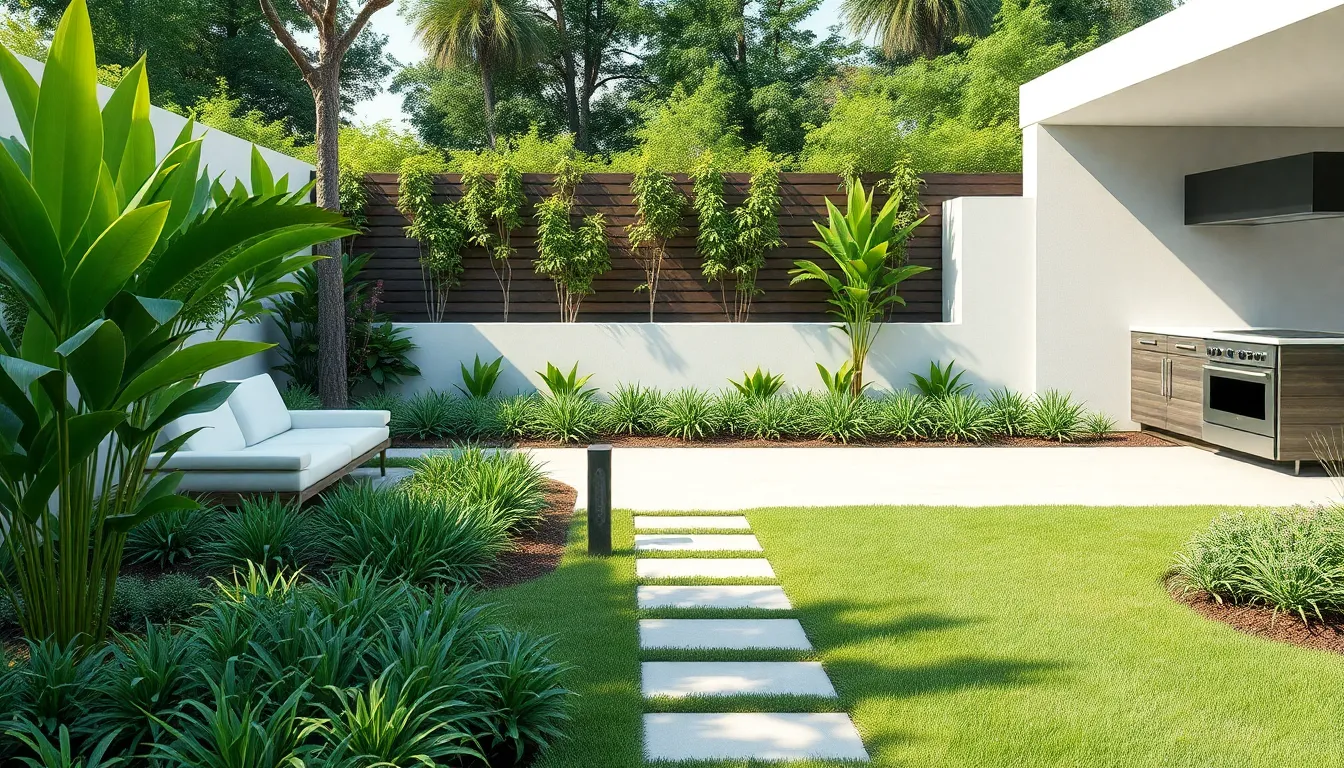Phone:
(701)814-6992
Physical address:
6296 Donnelly Plaza
Ratkeville, Bahamas.

In a world where concrete jungles reign supreme, the modern garden emerges as a lush oasis of creativity and tranquility. It’s not just about throwing a few daisies in the dirt anymore; today’s gardens are a harmonious blend of art and nature. Imagine sipping your morning coffee surrounded by vibrant colors and innovative designs that make your neighbors green with envy.
Modern garden design reflects a harmonious blend of nature and art. Creativity plays a crucial role, with landscapes transforming into serene retreats amidst urban settings. Each element in a modern garden focuses on functionality while enhancing aesthetic appeal.
Designers often incorporate various materials and textures to create visual interest. Stone pathways, wooden decks, and metal sculptures add depth to overall design. Plants are selected for their unique shapes and seasonal colors, ensuring year-round visual engagement.
Sustainable practices are integral to modern garden design. Water-efficient irrigation systems and native plant choices reduce maintenance needs and conserve resources. Gardens often feature spaces for relaxation and entertaining, integrating outdoor furniture that complements the overall theme.
Innovative technologies also influence contemporary designs. Smart lighting systems highlight key features while providing security. Vertical gardens maximize limited space and create stunning focal points using various plant species.
Accessibility is another vital aspect. Universal design principles enable everyone, including those with mobility challenges, to enjoy outdoor spaces. Designers prioritize seamless transitions between home interiors and gardens, allowing for a cohesive experience.
Color palettes in modern gardens emphasize simplicity and elegance. Grayscale landscapes with vivid plant accents draw attention and stimulate the senses. Seasonal planting schemes ensure constant renewal, inviting visitors to experience different moods throughout the year.
Ultimately, modern garden design showcases diverse expression and personal style. Each garden serves as a canvas for creativity, leaving a lasting impact on its surroundings while inviting tranquility and relaxation.

Modern garden design emphasizes simplicity and functionality, creating spaces that resonate with nature while enhancing aesthetic appeal.
Simplicity defines modern gardens, focusing on clean lines and uncluttered visuals. Minimalist designs embrace fewer elements to maximize impact. This approach allows essential features, such as plant textures and hardscape materials, to stand out. Using a limited color palette reinforces a cohesive look, ensuring harmony throughout the space. Intentionally placed plants contribute to an overall sense of balance, inviting a peaceful atmosphere. Less is more in modern gardens; therefore, each element plays a crucial role in the design’s success. Effective use of negative space creates breathing room, allowing visitors to appreciate the beauty surrounding them.
Functional spaces are at the heart of modern garden design. Each area serves a distinct purpose while promoting outdoor enjoyment. Designers often incorporate seating areas, pathways, and gardens that cater to various activities. Elements such as outdoor kitchens and fire pits enhance usability while fostering social interaction. Thoughtful planning allows for smooth transitions between spaces, making navigation effortless. Additionally, incorporating features like vertical gardens optimizes small areas, creating lush greenery where space is limited. Accessibility remains crucial, enabling everyone to enjoy the designed outdoor environment. Engaging with nature fosters relaxation and well-being, highlighting the importance of multifunctional spaces within contemporary designs.
Modern garden design embraces various styles that reflect current trends while enhancing the aesthetic appeal of outdoor spaces. Designers consider elements that blend function with beauty.
Contemporary aesthetics prioritize clean lines and minimalist features. This style emphasizes geometric shapes and symmetry, creating a visually appealing layout. Neutral color palettes dominate, allowing plants to add vibrant pops of color. Incorporating glass, metal, and stone elements enhances the modern feel and contributes to the overall harmony of the garden. Water features like sleek fountains elevate the atmosphere, inviting tranquility. Organic shapes often contrast with straight lines, promoting a dynamic interplay between design elements.
Sustainable practices play a crucial role in modern garden design. Choices such as native plants enhance biodiversity, reducing water usage and maintenance requirements. Rain gardens and permeable pavements support natural drainage, minimizing runoff. Eco-friendly materials, including reclaimed wood and recycled stone, reduce environmental impact. Incorporating composting systems enriches soil quality, promoting healthy plant growth. Smart irrigation systems optimize water consumption, ensuring efficient usage in drought-prone areas. Overall, sustainable features not only benefit the environment but also foster a connection to nature within urban landscapes.
Modern gardens focus on combining functionality and aesthetics to create inviting outdoor spaces. Key components include hardscaping features and thoughtful plant selections.
Hardscaping involves incorporating materials like stone, concrete, and wood. Pathways, patios, and walls define spaces while enhancing the garden’s structure. Clean lines and geometric shapes often characterize these elements, promoting a minimalist aesthetic. Water features, such as ponds or fountains, add tranquility and attract wildlife. Seating areas, crafted from durable materials, encourage relaxation and social interaction. Integrating raised beds can create visual interest and improve accessibility for gardening enthusiasts.
Choosing the right plants enhances the garden’s design and environmental sustainability. Native species often thrive with less maintenance and support local ecosystems. Seasonal plantings create dynamic visuals throughout the year, ensuring changing colors and textures. Grouping plants by height and texture adds depth, while considering sunlight and water needs fosters healthy growth. Incorporating edible plants, such as herbs or vegetables, adds functionality. Exotic plants can provide unique focal points, enriching overall character.
Modern garden design represents a harmonious blend of creativity and functionality. By embracing innovative materials and sustainable practices, these gardens transform outdoor spaces into vibrant retreats. With a focus on accessibility and minimalist aesthetics, they invite everyone to enjoy nature’s beauty.
The thoughtful integration of hardscaping, water features, and native plants creates an inviting atmosphere that encourages relaxation and social interaction. As urban environments continue to evolve, modern gardens stand out as essential havens that enhance both personal expression and environmental sustainability. They not only beautify surroundings but also foster a deeper connection with nature.